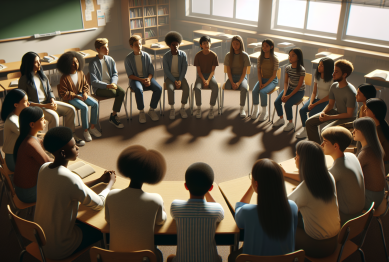In the world of education, there is often a drive for clear answers, well-defined solutions, and structured paths toward success. However, recent research and educational trends suggest that embracing ambiguity—uncertainty, complexity, and the lack of definitive answers—can actually make you smarter. In fact, it might be one of the best tools for fostering critical thinking, creativity, and intellectual growth.
So, how can ambiguity, something that typically feels uncomfortable, be beneficial? And why should educators and learners alike embrace uncertainty as a path to better understanding and enhanced cognitive abilities?
In this article, we’ll explore how ambiguity plays a crucial role in educational settings, why embracing uncertainty makes you smarter, and how educators and students can harness the power of ambiguity to unlock greater intellectual potential.

Why Ambiguity Makes You Smarter: The Surprising Benefits of Embracing Uncertainty in Education
In the world of education, there is often a drive for clear answers, well-defined solutions, and structured paths toward success. However, recent research and educational trends suggest that embracing ambiguity—uncertainty, complexity, and the lack of definitive answers—can actually make you smarter. In fact, it might be one of the best tools for fostering critical thinking, creativity, and intellectual growth.
So, how can ambiguity, something that typically feels uncomfortable, be beneficial? And why should educators and learners alike embrace uncertainty as a path to better understanding and enhanced cognitive abilities?
In this article, we’ll explore how ambiguity plays a crucial role in educational settings, why embracing uncertainty makes you smarter, and how educators and students can harness the power of ambiguity to unlock greater intellectual potential.
What is Ambiguity and How Can It Enhance Your Learning?
Ambiguity refers to situations where information is unclear, open to multiple interpretations, or lacks straightforward answers. While ambiguity can make us feel uneasy, it is also a powerful tool in education. By introducing students to complex problems, grey areas, and open-ended questions, educators can foster an environment where critical thinking, problem-solving, and independent learning are at the forefront.
In contrast to traditional learning approaches, which often emphasize rote memorization or following rigid steps, embracing ambiguity challenges learners to make sense of the unknown, process information critically, and generate their own conclusions. This approach encourages students to:
-
Engage with difficult, multifaceted problems
-
Tolerate uncertainty and ambiguity in decision-making
-
Build resilience when faced with incomplete or contradictory information
-
Develop higher-order cognitive skills
In essence, ambiguity shifts the focus from “getting the right answer” to “understanding the process”—a mindset that is crucial for cultivating deeper learning and intellectual development.
How Ambiguity Fosters Smarter Critical Thinking Skills
1. How Ambiguity Strengthens Your Analytical Abilities
Critical thinking involves the ability to analyze, evaluate, and make decisions based on evidence. However, critical thinking is not just about analyzing clear-cut data—it’s about recognizing complexity and ambiguity in the information presented.
When faced with ambiguity, individuals are forced to engage more deeply with the material. They must ask questions, make connections, and critically assess various perspectives. This strengthens their ability to think critically, as they are required to navigate uncertainty and evaluate multiple possible outcomes or interpretations.
A study by University College London suggests that encountering ambiguity and unresolved problems helps individuals improve their analytical skills, as they need to process complex information more effectively. The more often someone tackles ambiguous problems, the better they become at thinking critically in any scenario.
2. The Link Between Ambiguity and Creative Problem Solving
Innovation often arises from the willingness to venture into uncharted territories and entertain uncertainty. Ambiguity forces individuals to explore new possibilities, take creative risks, and think outside of conventional norms. Rather than adhering to set patterns, people are encouraged to develop original ideas and solutions to ambiguous problems.
Research from the University of California, Berkeley, shows that students exposed to ambiguous situations develop better creative problem-solving skills compared to those who work with well-defined problems. These students are more likely to use imaginative thinking to devise solutions when faced with an open-ended question.
Practical Strategies to Use Ambiguity to Improve Learning Outcomes
If ambiguity is so beneficial, how can it be effectively introduced in educational settings? Here are some strategies for educators looking to incorporate ambiguity into their teaching practices:
1. Use Open-Ended Questions to Encourage Exploration
One of the most effective ways to introduce ambiguity in the classroom is through open-ended questions. These questions don’t have a single correct answer but encourage exploration, discussion, and critical analysis. For example:
-
“How can we solve climate change?”
-
“What are the potential impacts of artificial intelligence on society?”
-
“What makes a person ‘good’ or ‘evil’?”
These types of questions force students to grapple with uncertainty, examine different viewpoints, and explore the complexities of the issue at hand.
2. Foster Problem-Based Learning for Smarter Solutions
Problem-based learning (PBL) is a teaching method that focuses on students solving real-world, open-ended problems. In PBL, the teacher provides a problem but does not necessarily give a clear solution. Students are then tasked with researching, analyzing, and developing their own strategies for solving the problem.
This method encourages students to embrace ambiguity, as they often encounter multiple possible solutions and must determine the best approach. By working through this uncertainty, students develop problem-solving skills, creativity, and resilience.
3. Promote Reflective Thinking to Navigate Ambiguous Information
Ambiguity also fosters reflective thinking, as students must constantly assess their own understanding and adapt their learning strategies. To encourage reflection, educators can use tools like journals, group discussions, and peer reviews. These activities help students evaluate their thought processes and refine their understanding over time.
4. Introduce Real-World Complexities to Build Smarter Thinkers
Another way to incorporate ambiguity is by presenting students with real-world issues that lack easy answers. For example, educators can introduce topics like global poverty, climate change, or political polarization, all of which involve complex, ambiguous challenges. By engaging with these topics, students are better equipped to navigate uncertainty and apply critical thinking to solve real-world problems.
Why Ambiguity is Essential for Smarter Learners and Future Success
In a rapidly evolving world, the ability to navigate ambiguity is becoming increasingly important. Many of the challenges we face today—ranging from climate change to global health crises—don’t have simple solutions. In fact, many of these problems are inherently ambiguous, requiring innovative thinking, adaptability, and creativity to address.
As we move into an increasingly uncertain future, students must be equipped not only with technical skills but also with the ability to think critically, adapt to changing circumstances, and solve complex, ambiguous problems. These are the skills that will make individuals smarter, more resilient, and more prepared for the future.
Moreover, as the workplace continues to evolve, the demand for skills like problem-solving, adaptability, and creative thinking will only increase. Ambiguity plays a crucial role in preparing students for these demands, as it forces them to engage with uncertainty and develop the skills needed to thrive in an unpredictable world.
How Learners Can Benefit from Ambiguity and Become Smarter Through Exploration
While educators play a vital role in introducing ambiguity into the learning process, students can also take steps to harness the cognitive benefits of ambiguity in their own learning journey:
1. Embrace Uncertainty and Explore Smarter Pathways
When you encounter ambiguous situations or problems, don’t shy away from them. Instead, embrace the uncertainty and allow yourself the freedom to explore different angles, make mistakes, and learn from your experiences. The more comfortable you are with ambiguity, the better you will become at processing complex information.
2. Practice Creative Problem-Solving in Ambiguous Scenarios
Take on projects or challenges that lack clear, structured solutions. Whether it’s through personal projects, academic tasks, or real-world problems, intentionally seek out situations that require creative thinking and adaptability. This will help you become more comfortable with ambiguity and improve your problem-solving skills.
3. Engage with Diverse Perspectives to Build Smarter Understanding
When faced with ambiguity, gather different viewpoints. Engage in discussions with peers, mentors, or experts in the field to explore multiple perspectives. This will deepen your understanding and help you navigate uncertainty with confidence.
Conclusion: Embracing Ambiguity to Become a Smarter, More Resilient Learner
While ambiguity may feel uncomfortable at first, it offers substantial cognitive benefits that can enhance critical thinking, creativity, and problem-solving abilities. By embracing uncertainty, both students and educators can unlock the intellectual growth that comes from engaging with complex, open-ended problems. In a rapidly changing world, the ability to navigate ambiguity is not just a valuable skill—it’s a critical one.
By incorporating ambiguity into the learning process, we prepare ourselves for a future that demands flexibility, creativity, and the courage to confront the unknown. Embrace ambiguity, and you’ll find that it makes you smarter and more adaptable in ways you never expected.
Reference
- Critical Thinking and Ambiguity: https://www.ucl.ac.uk/
- Creativity and Innovation through Ambiguity: https://www.berkeley.edu/
- Problem-Based Learning and Ambiguity: https://www.nejm.org/









